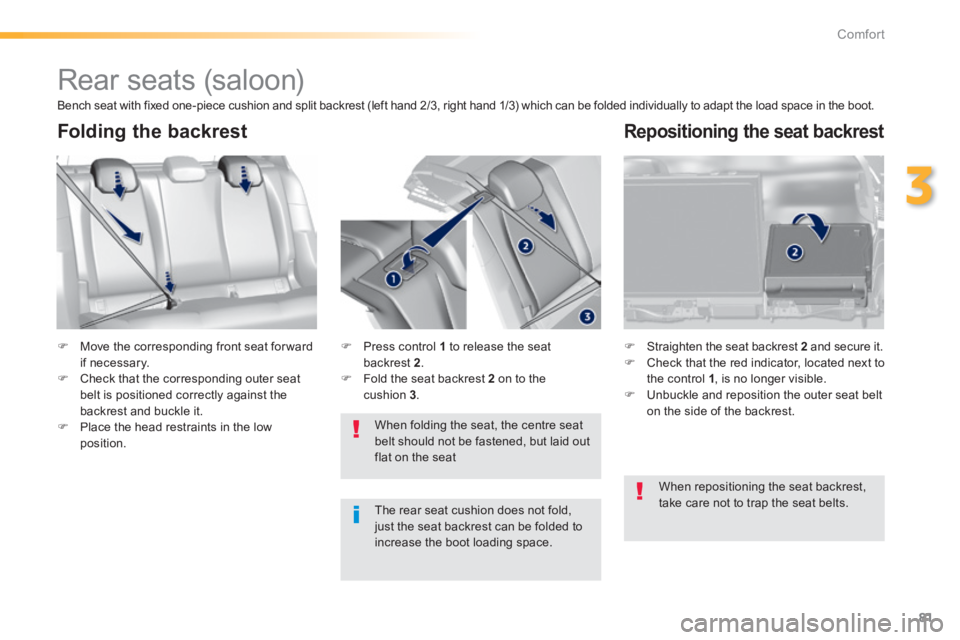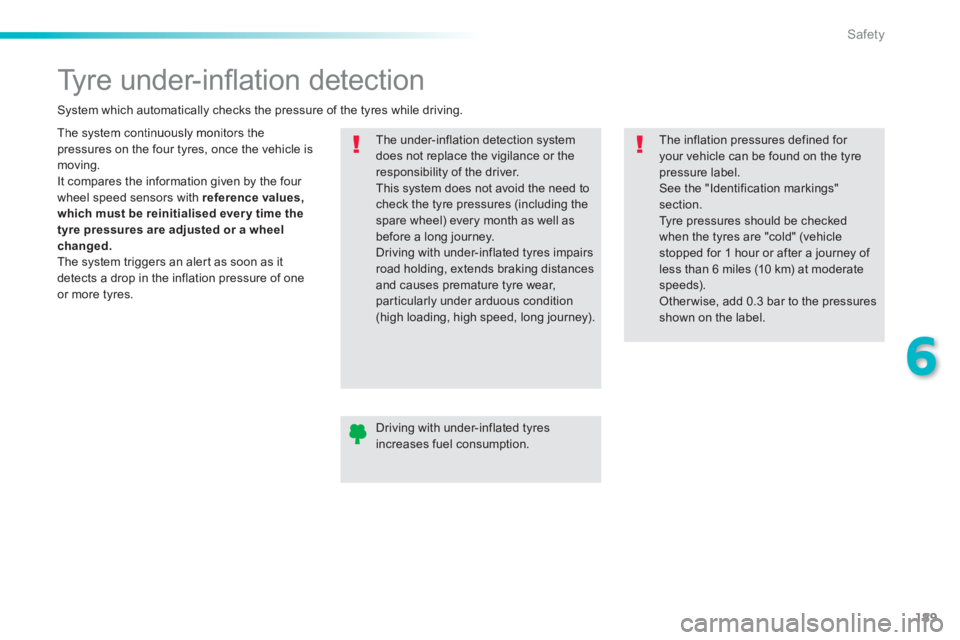Page 83 of 400

81
3
Comfort
308_EN_CHAP03_CONFORT_ED02-2013
Rear seats (saloon)
Move the corresponding front seat for ward if necessary. Check that the corresponding outer seat belt is positioned correctly against the backrest and buckle it. Place the head restraints in the low position.
Straighten the seat backrest 2 and secure it. Check that the red indicator, located next to the control 1 , is no longer visible. Unbuckle and reposition the outer seat belt on the side of the backrest. When folding the seat, the centre seat
belt should not be fastened, but laid out flat on the seat
Press control 1 to release the seat backrest 2 . Fold the seat backrest 2 on to the cushion 3 .
Folding the backrest Repositioning the seat backrest
Bench seat with fixed one-piece cushion and split backrest (left hand 2/3, right hand 1/3) which can be folded individually to adapt the load space in the boot.
The rear seat cushion does not fold, just the seat backrest can be folded to increase the boot loading space.
When repositioning the seat backrest, take care not to trap the seat belts.
Page 85 of 400
83
3
Comfort
308_EN_CHAP03_CONFORT_ED02-2013
These have one position for use (up) and a stowed position (down). They can be removed and are interchangeable.
Outer rear seat head restraints
Never drive with the head restraints removed; they must be in place and correctly adjusted.
To remove a head restraint: pull the head restraint upwards to the stop, then, press the lug A .
The centre head restraint is not adjustable.
Pull the control 1 for wards, the seat backrest folds onto the cushion.
Returning the seat back to
its original position
Put the seat back in the upright position and secure it. Check that the red indicator, located at the control 1 , is no longer visible. Refit the head restraints or put them back in place.
When returning the rear seat back to its original position, take care not to trap the seat belts and ensure that their buckles are positioned correctly.
Page 87 of 400
85
3
Comfort
308_EN_CHAP03_CONFORT_ED02-2013
Mats Removable carpet protection.
When fitting the mat for the first time, on the driver's side use only the fixings provided in the wallet attached. The other mats are simply placed on the carpet.
Fitting Removal Refitting
To avoid any risk of jamming of the pedals: - only use mats which are suited to the fixings already present in the vehicle; these fixings must be used, - never fit one mat on top of another. The use of mats not approved by PEUGEOT may inter fere with access to the pedals and hinder the operation of
the cruise control / speed limiter. The mats approved by PEUGEOT have two fixings located below the seat.
To remove the mat on the driver's side: move the seat as far back as possible, unclip the fixings, remove the mat.
To refit the mat on the driver's side: position the mat correctly, refit the fixings by pressing, check that the mat is secured correctly.
Page 95 of 400
93
3
Comfort
308_EN_CHAP03_CONFORT_ED02-2013
To install
Position the left and then right hand ends of the luggage cover in their respective housings. Place your hands on the roller then turn the assembly to the rear to secure it. Unreel the roller blind until it locks on the rear pillar.
Page 122 of 400

120
Driving
308_EN_CHAP04_CONDUITE_ED02-2013
SituationsConsequences
Display of the message " Parking brake fault " and of the following warning lamps: The parking brake is faulty, the manual and automatic functions may not operate. When stationary , to immobilise your vehicle: When stationary , to immobilise your vehicle: When stationary - Pull and hold the control lever for about 7 to 15 seconds, until the warning lamp comes on in the instrument panel. If this procedure does not work, you should make your vehicle safe: - Park on a level sur face. - Engage a gear. - If possible, fit a wheel chock. Call on a PEUGEOT dealer or a qualified workshop.
Display of the message " Parking brake fault " and of the following warning lamps: - The parking brake does not have its full per formance to securely hold the vehicle in all situations. You should make your vehicle safe: - Park on a level sur face. - Engage a gear. - If possible, fit a wheel chock. Call on a PEUGEOT dealer or a qualified workshop. The flashing of the P warning lamps on starting the vehicle indicates that the parking brake is not correctly applied. As soon as possible, stop the vehicle and try to completely release the parking brake, using the control lever, with your foot on the brake pedal.
Display of the message " Battery fault " and the following warning lamp: - The state of charge of the battery is very low and requires immobilisation of the vehicle in a safe place.
- Once the battery is completely discharged, the controls do not operate: to release the parking brake, call on a PEUGEOT dealer or a qualified workshop.
Page 189 of 400
187
6
Safety
308_EN_CHAP06_SECURITE_ED02-2013
Automatic operation of
hazard warning lamps
Direction indicators
Left: lower the lighting stalk passing the point of resistance. Right: raise the lighting stalk passing the point of resistance.
Three fl ashes of the direction indicators
Hazard warning lamps
A visual warning by means of the direction indicators to alert other road users to a vehicle breakdown, towing or accident. Press this button, the direction indicators flash. They can operate with the ignition off.
Press briefly upwards or downwards, without going beyond the point of resistance; the direction indicators will flash 3 times.
When braking in an emergency, depending on the rate of deceleration, as well as when the ABS regulation is invoked or in the event of an impact, the hazard warning lamps come on automatically. They switch off automatically the first time you accelerate. You can also switch them off by pressing the button.
Page 190 of 400
188
Safety
308_EN_CHAP06_SECURITE_ED02-2013
Horn
Press the central part of the multifunction steering wheel.
Audible warning system to alert other road users to an imminent danger.
Use the horn moderately and only in the following circumstances: - immediate danger, - overtaking a cyclist or pedestrian, - approaching a location lacking visibility.
Emergency or
assistance call
This system allows you to make an emergency or assistance call to the emergency services or to the dedicated PEUGEOT service.
For more information on the use of this function, refer to the "Audio equipment and telematics" section.
Page 191 of 400

189
6
Safety
308_EN_CHAP06_SECURITE_ED02-2013
Tyre under-infl ation detection
The system continuously monitors the pressures on the four tyres, once the vehicle is moving. It compares the information given by the four wheel speed sensors with reference values, which must be reinitialised ever y time the tyre pressures are adjusted or a wheel changed. The system triggers an alert as soon as it detects a drop in the inflation pressure of one or more tyres.
The under-inflation detection system does not replace the vigilance or the responsibility of the driver. This system does not avoid the need to check the tyre pressures (including the spare wheel) every month as well as before a long journey. Driving with under-inflated tyres impairs road holding, extends braking distances and causes premature tyre wear, particularly under arduous condition (high loading, high speed, long journey).
System which automatically checks the pressure of the tyres while driving.
The inflation pressures defined for your vehicle can be found on the tyre pressure label. See the "Identification markings" section. Tyre pressures should be checked when the tyres are "cold" (vehicle stopped for 1 hour or after a journey of less than 6 miles (10 km) at moderate speeds). Other wise, add 0.3 bar to the pressures shown on the label.
Driving with under-inflated tyres increases fuel consumption.